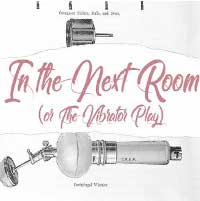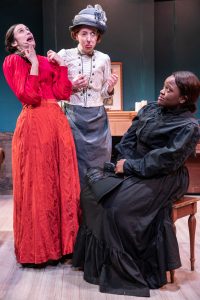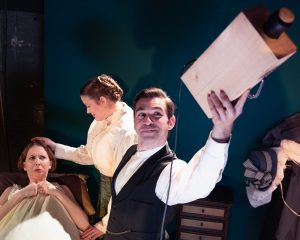
 [rating=4]When Sarah Ruhl’s smart, intricately woven script about repressed sexuality during the 1880s meets up with the Idle Muse Theatre Company’s brilliant acting, the result is unsurpassed. Bold, brash, and tastefully done, “In the Next Room (or the Vibrator Play)” is a refreshing, comical take on sex and intimacy in the Victorian Era. Set in New York, this cleverly inspired performance, directed by Morgan Manasa, is framed around the diagnosis of hysteria, which was then thought to be a mental disorder originating from some dysfunction of the womb.
[rating=4]When Sarah Ruhl’s smart, intricately woven script about repressed sexuality during the 1880s meets up with the Idle Muse Theatre Company’s brilliant acting, the result is unsurpassed. Bold, brash, and tastefully done, “In the Next Room (or the Vibrator Play)” is a refreshing, comical take on sex and intimacy in the Victorian Era. Set in New York, this cleverly inspired performance, directed by Morgan Manasa, is framed around the diagnosis of hysteria, which was then thought to be a mental disorder originating from some dysfunction of the womb.
The 1880s was a decade that that saw the mass production of Edison’s light bulb, one of the first inventions created by the harnessing of electrical power. Other inventions that used electricity followed, including the vibrator, a clinical device invented by Dr. Givings (Joel Thompson) and designed to treat women’s bouts with hysteria—and men’s bouts with the disease in rare cases. Some portion of the show is thus devoted to having the audience watch the use of the vibrator and witness several patients’ surprisingly positive consequences first-hand. Apparently, the use of this new device helped to relieve their stress and made each of them more cheerful and less obsessive and petulant.
But when Mrs. (Catherine) Givings (Kristen Alesia) continually overhears patients’ screams from the next room, she becomes just a little too curious about what exactly is going on. Young, energetic, and extremely talkative, she initially enlists the more refined Mrs. (Sabrina) Daldry (Christina Renee Jones) to tell her about her medical treatments; and when Catherine’s curiosity is insatiable, they break into the doctor’s office, adjacent to the Givings’ living room. Now in her husband’s operating theatre, Catherine sees the vibrator first-hand, and we can only guess what happens next. The second act is even better than the first.
Despite the fact that Dr. Givings is a specialist in gynecology and hysteria, the wisest person in the story with regard to sex turns out to be Elizabeth (Michelle R. Bester), an African-American woman with two children of her own. With the end of slavery, she has trouble making ends meet, so she works as a paid domestic for Mr. and Mrs. Daldry while simultaneously serving as a wet nurse to the Givings. When Catherine and Mrs. Daldry relate their varying sexual feelings and experiences (with the vibrator), Elizabeth immediately recognizes that this is what each of them should have experienced while having relations with their husbands. Their honest, confidential dialogue points up the larger reality of that time period: that it was the wealthier white women who often never reached climax and probably never experienced sex for pleasure. While it was a given that (most) men needed to have their basic sexual needs fulfilled, white middle-class women were looked upon as being chaste and not having any such desires. In contrast, Elizabeth furthers the pre-Civil War stereotype that blacks had fewer sexual inhibitions than whites and could more easily combine passion with lovemaking.
That said, the end of the 19th century marked a time when modern philosophy dictated that sex was supposed to be largely mechanical, rather than poetical. Romantic philosophy, or Romanticism, which prevailed largely from 1800 to 1850, was now out of fashion and thought to be fanciful and irrelevant. (Think of the poets Byron, Keats, and Shelley.) Instead, it had been replaced by logical positivist philosophy, otherwise known as positivism, considered modern and scientific and a spur to technological advance. (Think of the man in the white lab coat and the dictates of cause and effect in a deterministic universe.) As the height of the industrial revolution made the machine primary, so it was with understandings of sexuality; where intimate knowledge became shielded in rituals and customs while its study became more strictly part and parcel of science and medicine. Medical practitioners thus had to be devoid of personal feelings when dealing with their patients, so as not to compromise their professionalism, objectivity, and ethical standards essential to doing their work competently.
In the play, Dr. Givings and his assistant Annie (Erin Gallagher) generally keep a tight rein on their emotions and focus on what it means to be a consummate professional. Their sexual feelings, however, intrude over the course of time. Whereas the doctor is a straight man who fails to understand romance, Annie appears to be a closet lesbian. Leo (Chad Bay), a professional artist and one of the doctor’s patients, might have been a closeted gay man or bisexual or straight; we don’t really know. What we do know is that he is a throwback to the earlier romantic era, more interested in painting a portrait of a contemporary Virgin Mary—and more taken with religion and aesthetics than science. Then there is Mr. Daldry (Brendan Hutt), who simply wants his wife’s health to improve, whatever it takes. He is a good person who does what is expected of him and is the epitome of the average man of that era.
Set design, complete with a living room and adjacent doctor’s office is nicely conceived by Milo Bue, such that a very small stage has the illusion of size. By allowing the audience to see through the wall between the two rooms, the director can easily shift the action seamlessly from one part of the stage to the other. The night I attended the performance, the doorknob between these two rooms had somehow broken off and the actors had to force open a door that was stuck. This was followed by one of the actors placing an item on the floor to keep the door propped open, creating an unfortunate situation where audience members had to imagine that a lock on an already open door still needed to be picked using a hatpin. The issue with the malfunctioning latch, however, was remedied between acts one and two, when a drill was brought in to make needed repairs.
Costume design by Stefanie Johnsen captures the spirit of the era, not to mention the fact that the clothes themselves are beautiful. The task of designing apparel for this show involved mastering the details of the outer garments plus all the inner garments of that era, including bustles, corsets, underdresses, pantalets, stockings, drawers, and all other manner of underwear. Intimacy design by Samantha Kaufman and Maureen Yasko was essential for this entire play to come together as it should, considering the many intrusions on personal space with all of the dressing and undressing of the characters and the (inoffensive) application of the vibrator. The modesty of the late 1800s had to be respected as well as the sensibilities of modern theatregoers.
The Idle Muse Theatre Company’s performance of “In the Next Room (or the Vibrator Play)” is an intimate portrait in more ways than one. This adult comedy inspires us to think about how things have changed in the bedroom since Victorian times. Watching this show can facilitate a frank discussion with a friend, spouse, relative, or intimate partner about sex, intimacy, romance, and other aspects of making love. In this way, we can better determine what a healthy loving relationship might consist of, not to mention the many twists and turns that ardent passion—and a possible mechanical assist—might take.
“In the Next Room (or the Vibrator Play)” is playing through April 5, 2020at the Edge Theatre Off Broadway at 1133 W. Catalpa Avenue, Chicago.
Performance schedule:
Thursdays, Fridays, Saturdays – 8:00 p.m.
Sundays – 3:00 p.m.
Added performance – Wednesday, March 25 at 8:00 p.m.
Tickets are $20 for adults, 65 years and younger
$15 for adults over 65 years old and students (any age)
Industry night is every Thursday during the run with $10 tickets for industry members.
Tickets are on sale now at www.idlemuse.org; or by calling 773-340-9438.
To see what others are saying, visit www.theatreinchicago.com, go to Review Round-Up and click at ” In The Next Room ( or The Vibrator Play)”.






More Stories
“The Woman in Black” MILWAUKEE reviewed by Amy Menzel
“The Man Who Came To Dinner” reviewed by Julia W. Rath
” Manual Cinema’s The Magic City”